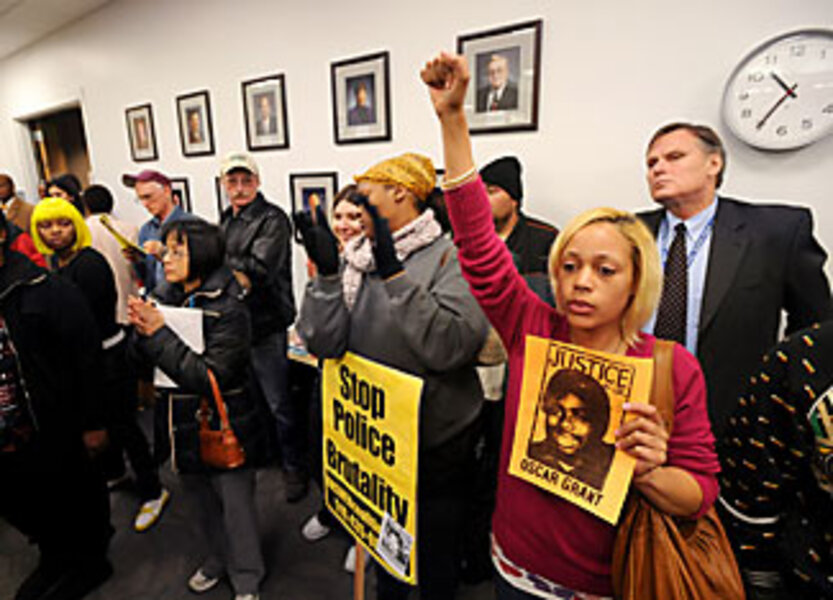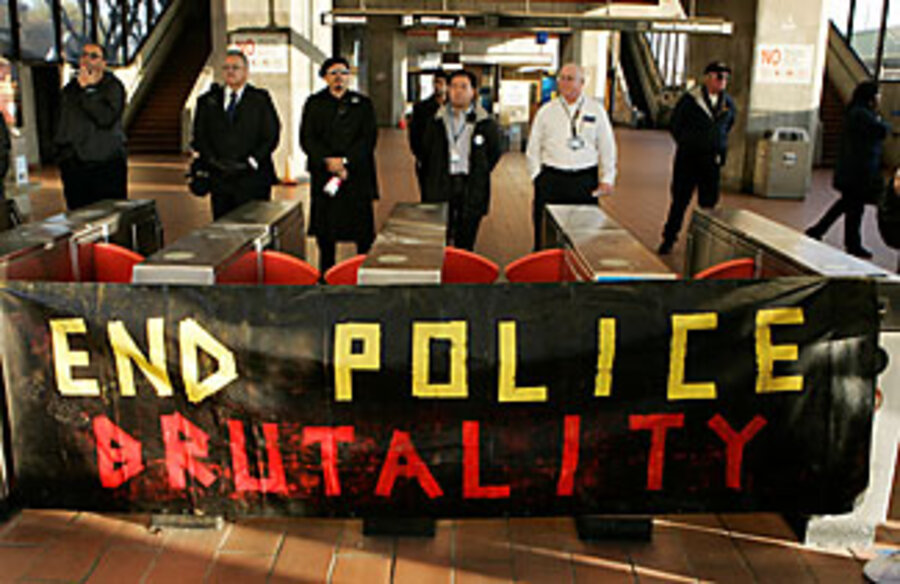In video age, a rush to judgment?
Loading...
| Oakland, Calif.
If a picture is worth a thousand words, the videos of a uniformed police officer shooting an unarmed man lying on his belly are worth, in the eyes of many Oakland residents, at least three: Arrest the cop.
The police killing of Oscar Grant III has drawn national attention and already sparked a riot last week in downtown Oakland. The young black man was in a group pulled off a train here early on New Year's Day by transit police responding to reports of rowdy passengers.
Public hearings this past weekend revealed escalating anger with officials overseeing the investigations into the incident. The district attorney has projected that charges, if any, could take another 10 days. Community leaders say that pace is unacceptable given the "conclusive" footage.
But in a time when cellphone video is demanding greater police accountability, sometimes eyewitness video can also make the story more complex.
A new study calls into question the entire notion of a "conclusive video." Researchers interviewed hundreds of people about a tape that eight Supreme Court justices deemed so incontrovertible that it formed the basis of a summary judgment. It turned out, however, that many people interpreted the footage quite differently.
"If there's one lesson in this [study], it should be that we don't make the mistake of thinking that the tape speaks for itself," says Dan Kahan, a Yale law professor and lead author of the study to be published in the forthcoming Harvard Law Review.
"You've got to have all the evidence in the case. What people were thinking, what people heard, what's going on outside the camera frame," he says.
The research jumped off the Scott v. Harris decision of 2007, a case that revolved around the use of deadly force by police during a car chase. Video from inside a cruiser proved so compelling for eight of the nine justices that they took the unprecedented step of uploading it to the court's website to allow the tape "to speak for itself."
Mr. Kahan and his colleagues decided to ask a diverse sample of 1,350 people across the country whether the video spoke to them in similar ways. Roughly 75 percent of those interviewed said that deadly force was warranted – as the court majority verdict did – with the remaining quarter disagreeing. The divide mapped along recognizable social divisions such as race, ideology, and religion.
"People who have different ideas about how society works interpret what look like plain old facts differently," says Kahan.
Watching a video, he says, requires interpreting what happened before the camera started rolling, what's happening outside the frame, and what's going on in the minds of the people shown.
Police action in a video age
Interpretations notwithstanding, the increasing ubiquity of cellphone video has ensured greater police accountability.
Last July, for instance, in an incident between a rookie New York City cop and a cyclist, the officer claimed that the cyclist deliberately steered into him. Video of the incident, however, indicated the opposite to be true – resulting in the officer being charged with assault and harassment.
Still, police often act oblivious to the cameras and their superiors have been slow to recognize the public relations urgency they create.
Most attending the public hearings and street demonstrations in Oakland feel the videos in the Grant case show his killing to be unjustified. "Two of the four videos are conclusive as far as what took place," says local pastor Dion Evans.
The videos show Mr. Grant prone on the station platform being restrained by two white officers. Pastor Evans says Grant appears to be "squirming" because he's on someone else's legs. He describes how Officer Johannes Mehserle stands up, grabs his gun, "points in a way [Mehserle] can see the weapon," and then shoots.
However, others see the squirming as resisting arrest, and see in Mr. Mehserle's face a look of surprise after the gun fires – prompting speculation of an accidental discharge or taser mix-up. "I don't see anything in this video that's condemning enough to warrant charging this officer until an investigation has been completed," says Tom Aveni, an expert on questionable police shootings with the Police Policy Studies Council.
Mehserle resigned to avoid making a statement.
Mr. Aveni says he's hesitant to draw much from the videos because he can't make out where Grant's hands are. "That's a focal issue as to whether or not the officer thought the suspect was trying to access a weapon."
For George Holland, head of the Oakland chapter of the NAACP, the videos are "overwhelming compelling evidence." They leave less up for interpretation than the video of police beating Rodney King in 1991, he says, because they are augmented by audio and many independent witnesses.
"When there's a cop involved, [investigators] always go slow, we know that. But this is so outrageous ... the evidence is so overwhelming," says Mr. Holland.
Bay Area Rapid Transit police chief Gary Gee says the investigation is wrapping up. "We are going to finish this thing as quickly as we can," he says, adding, "The videos are one piece of evidence and you can't draw a conclusion on it alone."
Concern over delays
There are many reasons why the community here wants a quicker investigation and arrest. Delays tend to benefit the defendant, Holland says. And "thugs and vandals," he adds, can exploit delays to stir up trouble like last week's violence.
More than 100 rioters smashed storefront windows and parked cars last Wednesday night, after an evening of peaceful protest. "What happened to the guy that got shot is clearly wrong, but I just don't agree with how people are handling it" with violence, said Oakland resident Mike Sikoyak.
But he also expressed a common refrain: "If it was any of us that had shot anybody else, we would have been arrested and locked up."






